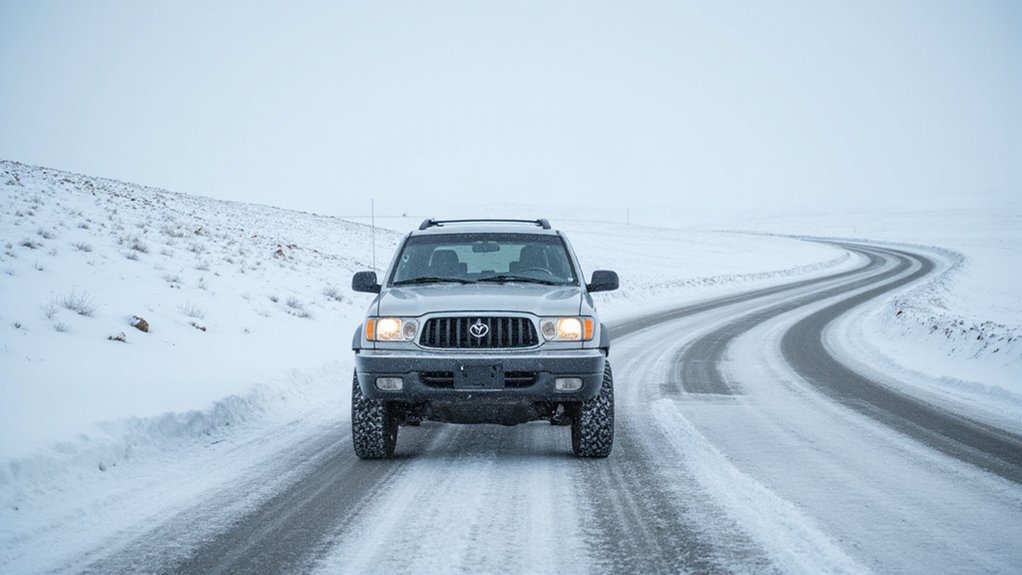Winter driving demands smart preparation to avoid getting stuck. Equip your vehicle with winter tires, check battery performance, and pack an emergency kit with blankets and supplies. Drive smoothly, anticipate road challenges, and avoid sudden movements that can cause skids. Maintain steady speeds, brake gently, and steer carefully in slippery conditions. Uncover more strategies to keep your winter expedition safe and tow-free.
Vehicle Preparation: Essential Winter Maintenance Checklist
When winter approaches, preparing your vehicle becomes essential for safe and reliable transportation. You'll want to start by checking your tire tread depth and considering winter-specific tires for better grip on snowy roads.
Don't forget to test your battery, as cold temperatures can reduce its performance dramatically. Inspect your windshield wipers and top off winter-grade washer fluid that won't freeze.
Verify your antifreeze levels are correct and that belts and hoses aren't cracked or brittle. A well-maintained vehicle isn't just about avoiding breakdowns—it's about keeping you and your loved ones safe during challenging winter conditions.
If you do experience a breakdown, roadside assistance services in Cleveland can provide quick and professional help during emergencies.
Emergency Kit Essentials: What Every Driver Must Pack
After ensuring your vehicle is winter-ready, the next critical step is preparing an emergency kit that could potentially save your life during unexpected roadside situations.
Pack warm blankets, extra gloves, and thermal clothing to protect against freezing temperatures. Include high-energy snacks, bottled water, a first-aid kit, and battery-powered flashlights with extra batteries.
Don't forget essential tools like a small shovel, ice scraper, jumper cables, and basic car repair items. A charged portable phone charger and reflective warning triangles can signal for help if you're stranded, ensuring your safety and peace of mind during challenging winter conditions. In case of severe issues, having roadside assistance contact information readily available can provide critical support during emergency towing situations.
Tire Technology and Traction: Selecting the Right Winter Gear
Because winter driving demands specialized equipment, selecting the right tires can mean the difference between safe passage and potential roadside disaster. Winter tires aren't just a luxury; they're a critical safety investment.
Their unique rubber compounds and specialized tread patterns provide superior grip on cold, icy surfaces, dramatically improving your vehicle's handling and stopping distance. You'll want to look for tires with the mountain/snowflake symbol, indicating they meet strict performance standards.
Don't compromise on quality—your safety depends on these four critical contact points between your vehicle and the treacherous winter road.
Advanced Driving Techniques for Slippery Road Conditions
Having equipped your vehicle with the right winter tires, commanding advanced driving techniques becomes the next critical step in traversing slippery road conditions.
When traversing icy roads, you'll want to maintain a steady, smooth driving approach. Avoid sudden movements like hard braking or sharp turns that could cause skidding. Instead, anticipate potential challenges by looking far ahead and gradually adjusting your speed. Your goal is to stay calm and in control, keeping a safe following distance from other vehicles.
Gentle acceleration and deceleration are key to maintaining traction and preventing dangerous slides.
Navigating Skids, Slides, and Unexpected Winter Challenges
Most winter drivers will encounter at least one heart-stopping moment when their vehicle suddenly loses traction, altering a routine drive into a potential emergency.
When a skid happens, don't panic or slam on the brakes. Instead, steer gently into the direction of the slide, easing off the accelerator and maintaining a light, steady touch.
Your goal is to regain vehicle control smoothly and predictably. Practice these techniques in a safe, controlled environment before winter's challenges arrive.
Understanding how your car responds during unexpected slides can change a potentially dangerous situation into a manageable, controlled response.
Weather Monitoring and Route Planning Strategies
How often do winter road conditions catch drivers off guard? More times than most would like to admit. You'll want to stay ahead of potential hazards by checking weather forecasts and road condition reports before heading out.
Local transportation websites and smartphone apps can provide real-time updates on snowfall, ice patches, and road closures. Plan your route carefully, allowing extra travel time and identifying alternative paths. Consider traffic patterns, elevation changes, and known trouble spots.
Frequently Asked Questions
Can I Use All-Season Tires Instead of Winter Tires During Snow?
You can use all-season tires, but they're not ideal for heavy snow. Winter tires provide better traction, handling, and safety when temperatures drop and roads get slippery.
How Long Can My Car Battery Last in Extreme Cold?
Your car battery can struggle in extreme cold, potentially losing up to 60% of its starting power. You'll want to test it regularly and keep your battery charged to prevent unexpected failures during winter.
Is It Safe to Warm up My Car in an Enclosed Garage?
You'll risk carbon monoxide poisoning if you warm up your car in an enclosed garage. It's dangerous and potentially fatal. Always start your vehicle in a well-ventilated area, preferably outside.
What Should I Do if I Get Stuck in Deep Snow?
If you're stuck in deep snow, don't panic. Gently accelerate, turn your wheels slowly, and use a shovel to clear around your tires. Rock the car back and forth carefully to gain traction.
How Do I Prevent My Windshield Wipers From Freezing?
You'll want to lift your wipers when parked, apply a winter-grade washer fluid, and use a silicone-based protectant to prevent freezing. Covering wipers with socks or plastic bags can also help keep them ice-free.



